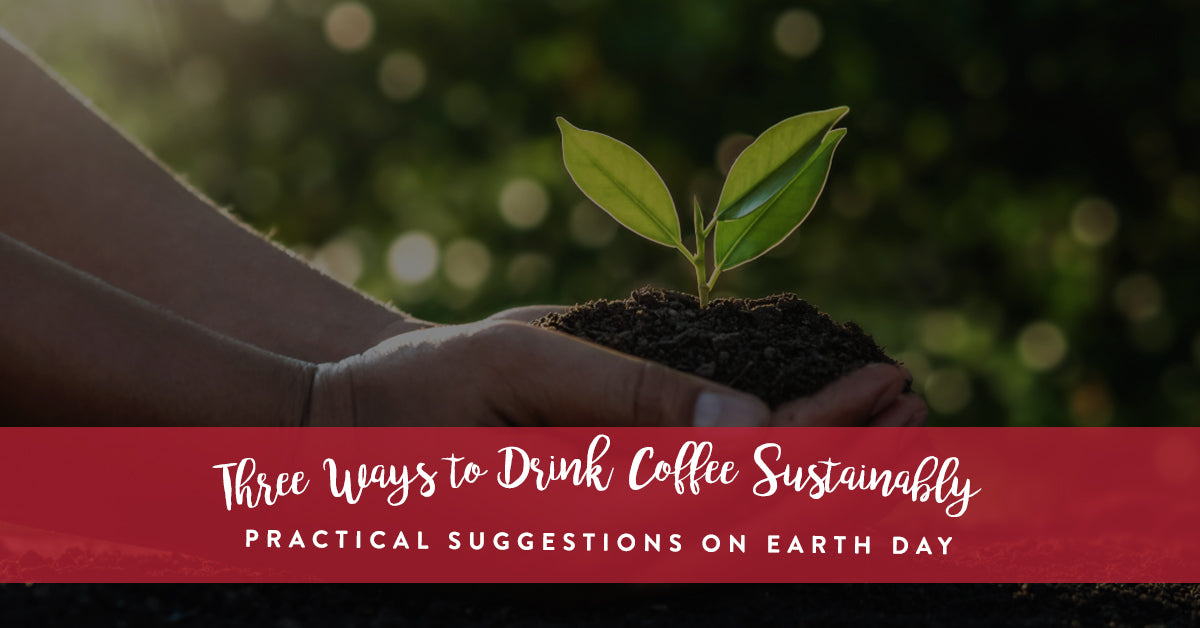
April 21, 2022
Three Ways to Drink Coffee Sustainably
Practical Suggestions on Earth Day
Each year since 1970, Earth Day has brought people across the globe together on 22nd April to raise awareness about environmental issues. This year, to mark Earth Day, we are offering a few practical tips for drinking coffee sustainably in an effort to help address the impact of the climate crisis on the coffee sector.
Some scientists predict that by 2050, only 25% to 50% of the current Coffee Belt (the main coffee producing countries which sit between the tropics) will be suitable for growing coffee as a result of climate change. If these predictions are accurate, the effects on the coffee industry, including the 125 million people who depend on coffee for their livelihood, will be devastating. In order to sustain themselves on lower yields, those who are still able to produce coffee will be forced to charge exponentially higher prices, including for coffee without certifications like Fair Trade and Organic. Not only will we have significantly less coffee for much higher prices, but the quality of what's available will be remarkably lower as well. It’s the higher quality Arabica beans that are the least resilient strain of coffee, grown at the highest elevations. Some forecasters estimate a 60% reduction in Arabica production in key producing countries, like Ethiopia and Brazil, by 2100.
Like most coffee producers and roasters, at Spiller & Tait we’ve taken our own steps to reduce the carbon footprint of our coffee production process. Most notably, we are proud that the majority of our coffee is now roasted on roasters with a catalytic converter carbon capture system, as well as a heat recirculation system. This cutting edge carbon reduction technology is significantly reducing the carbon emissions of our coffees. We look forward to quantifying that reduction for our customers in the future. We also employ other sustainable sourcing practices which you can learn more about here.
But much of the latest emissions research suggests that the majority of carbon emissions in the coffee sector, perhaps up to 90%, is generated during the consumption of coffee in cafes and homes, rather than during coffee growing and roasting. Which is why we feel there is an imperative for all coffee drinkers to find ways to help reduce their emissions. We are offering three practical suggestions for you to consider, irrespective of the brew method you choose:
1. Only Heat The Water You Need for Each Drink
The largest source of carbon emissions produced by cafes comes from the electricity used to heat water. As a customer, you can’t control what happens in your local coffee shop. But, you can control how much water you heat at home.
This can be as simple as leaving your home espresso machine off until you need it, or filling your kettle with the amount you need for each brew, rather than always filling to the top.
2. Reduce, or Replace, Dairy
If you drink milk-based coffees, then a simple and effective way to reduce your carbon impact is simply to choose a smaller cup size. This is especially true for take-away coffees from coffee shops, which tend to be larger than the dine-in equivalents, requiring more milk to fill them.
The dairy sector is a significant carbon emitter, equating to about 3.4% of global carbon emissions according to the UN, which is almost double the impact of aviation at 1.9%. This is because cows produce a lot of methane, which is a very potent greenhouse gas. So, just a small reduction in your milk consumption will make a significant dent in emissions over time.
You can take this one step further by using a milk alternative. While all of the plant based options have lower emissions than dairy, in our opinion the best pick is Oat Milk.
3. Reuse Coffee Grounds
Reusing coffee grounds as a replacement fertiliser helps to reduce another potent greenhouse gas, nitrous oxide, being released into the atmosphere when fertilisers are broken down by microbes in the soil.
Coffee grounds release much less nitrous oxide when broken down and have the added benefit of containing potassium, phosphorus and other micronutrients that promote plant growth. The quality and proportion of these nutrients vary, but studies have found that compost made with coffee grounds added to kitchen waste, is richer in nutrients than compost made with waste alone. For other ideas on how to reuse your coffee grounds see our blog.
By conducting further research on-line, you will find plenty of other ideas to help reduce your carbon footprint as a coffee drinker. In this blog we’ve focused on practical and easy to implement steps which will have a disproportionately significant impact on reducing your emissions.
Happy Earth Day!


